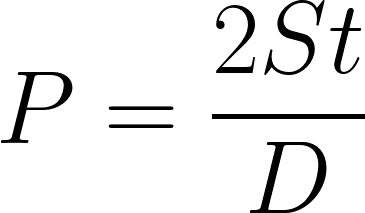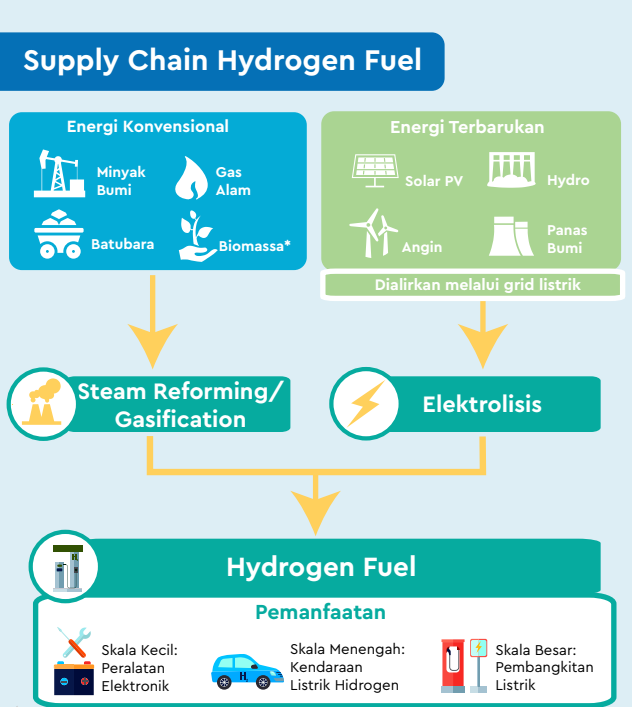Difference between revisions of "Muhammad Alvito Bintang Safero"
| Line 53: | Line 53: | ||
[[Tank Design:]] | [[Tank Design:]] | ||
Untuk penyimpanan hidrogen sebanyak 1 Liter saya menggunakan perhitungan yaitu Diameter 7 cm dan Tinggi 26 cm, sehingga V = 3,14 x 3,5 x 3,5 x 26 = 1.000,09 cm3. Untuk menghitung ketebalan tabung hidrogen, dapat ditentukan dengan mengikuti standar yang ada. Standar ini dapat bervariasi tergantung pada negara atau wilayah, dan dapat diacu dari pedoman seperti ISO 9809 atau DOT (Department of Transportation) untuk negara-negara tertentu. Kita dapat menghitung ketebalan tabung silinder menggunakan Barlow's formula: | Untuk penyimpanan hidrogen sebanyak 1 Liter saya menggunakan perhitungan yaitu Diameter 7 cm dan Tinggi 26 cm, sehingga V = 3,14 x 3,5 x 3,5 x 26 = 1.000,09 cm3. Untuk menghitung ketebalan tabung hidrogen, dapat ditentukan dengan mengikuti standar yang ada. Standar ini dapat bervariasi tergantung pada negara atau wilayah, dan dapat diacu dari pedoman seperti ISO 9809 atau DOT (Department of Transportation) untuk negara-negara tertentu. Kita dapat menghitung ketebalan tabung silinder menggunakan Barlow's formula: | ||
| + | |||
| + | [[File:Gif.gif]] | ||
t=P*D/(2*S*F), dimana t merupakan ketebalan minimal, P merupakan tekanan tabung (8 bar), D merupakan diameter tabung (7 cm), S merupakan besaran yield strength dari lapisan penyimpanan hidrogen (alumunium 7075 S=503Mpa), dan F merupakan faktor keamanan (3). | t=P*D/(2*S*F), dimana t merupakan ketebalan minimal, P merupakan tekanan tabung (8 bar), D merupakan diameter tabung (7 cm), S merupakan besaran yield strength dari lapisan penyimpanan hidrogen (alumunium 7075 S=503Mpa), dan F merupakan faktor keamanan (3). | ||
Revision as of 03:12, 5 June 2023
Consciousness
If we subtitute X = 1 in the equation (X^2 -1) /(X-1). This will result in 0/0 meaning undefined. Why so? Division is a mathematical operation that divides a number with another number to produce a certain value. To prove whether 0/0 is undefined. We can use the “Reductio Ad Absurdum” technique. The essence of “Reductio Ad Absurdum” reasoning is to prove that the proposition “P” is correct by taking the first step to consider the negation p, which is “~p”, to be the correct proposition. The second step deduces a contradiction based on the assumption that “~p” is true. Since the assumptions that have been established produce contradictions and contradiction are irrational, then the probability “~p” is true is rejected and it is concluded that p is true.
First assuming 0/0 is defined by producing a certain value. For a and b € R. 0/0 = a -> 0 = 0 x a (correct). 0/0 = b -> 0 = 0 x b (correct). Because a 0/0 division produces an unspecified and uncertain value and this contradicts the statement that 0/0 is defined by producing a certain certain value. Therefore, the assumption 0/0 defined is denegated to be 0/0 undefined.
We need to find answers by other methods. As a factoring method. (X^2 -1) /(X-1) = (X+1) (X-1)/(X-1). Then we can eliminate (X-1) and leave (X+1). Subtitute X = 1 to X + 1. The answer is 2.
Is Consciousness relevant to the previous case ? Do narate it ! why is that so?
In my opinion, consciousness arises from the complex computational processes that occur in the brain, which can be explained and understood through mathematical models. According to this perspective, brain nerve networks and their interactions can be explained mathematically, and consciousness is the emerging property of these computational processes.
However, it is important to note that mathematics, as a formal system, is not synonymous with consciousness itself. While mathematical models can help us understand and describe certain aspects of cognitive processes, they do not fully capture the subjective nature of conscious experience.
In short, while mathematics can be a valuable tool to understand and model certain aspects of brain function, it does not provide a complete explanation for consciousness.
Hydrogen Fuel
Hydrogen fuel is a non-emission fuel used as a fuel for power generation along with oxygen using a unit called hydrogen fuel cell. Hydrogen Fuel Cell works similarly to a battery, where a fuel cell has anode (-) and cathode (+) poles. Hydrogen (H2) is transferred to the anode pole which will subsequently break the hydrogen molecule into electrons and hydrogen ions. The flow of electrons on the external circuit will produce electricity. Meanwhile, hydrogen ions will react with oxygen (O2) which will produce water vapor. (H2O). The by-product of this reaction is only water vapor, so hydrogen fuel is a very clean type of energy. There are several methods for producing hydrogen as fuel. Currently, the most commonly used method is steam reforming using natural gas. In addition, there are several other methods such as gasification, electrolysis, as well as biological processes.
Steam Reformation In this process, the methane contained in natural gas is extracted and reacted with steam to produce hydrogen. About 95% of the hydrogen available on the market is produced by this process.
Gasification
In the process of gasification, coal or biomass materials are reacted with oxygen and steam to produce gas synthesis. Subsequently, hydrogen molecules are separated from gas synthesis using a separation system.
Electrolysis
The process of electrolysis uses a tool called an electrolyzer. The main concept of this process is the separation of hydrogen molecules as well as oxygen from water by reactions caused by electric flow.
The biological process
Microbes such as bacteria and microalgae can produce hydrogen by biological reactions using sunlight or organic matter. The technology is still in the research and development phase.
Design and Optimization of 1-Litre Pressurized Hydrogen Storage with 8 Bar Pressure Capability
Designing a 1-litre pressurized hydrogen storage system with the ability to hold a pressure of 8 bars within a budget of 500,000 Indonesian Rupiah (IDR) presents a challenge. In this essay, we will explore the considerations and possibilities of designing an efficient and cost-effective hydrogen storage system that meets the pressure requirement while staying within the given budget constraints.
Tank Design:
Untuk penyimpanan hidrogen sebanyak 1 Liter saya menggunakan perhitungan yaitu Diameter 7 cm dan Tinggi 26 cm, sehingga V = 3,14 x 3,5 x 3,5 x 26 = 1.000,09 cm3. Untuk menghitung ketebalan tabung hidrogen, dapat ditentukan dengan mengikuti standar yang ada. Standar ini dapat bervariasi tergantung pada negara atau wilayah, dan dapat diacu dari pedoman seperti ISO 9809 atau DOT (Department of Transportation) untuk negara-negara tertentu. Kita dapat menghitung ketebalan tabung silinder menggunakan Barlow's formula:
 t=P*D/(2*S*F), dimana t merupakan ketebalan minimal, P merupakan tekanan tabung (8 bar), D merupakan diameter tabung (7 cm), S merupakan besaran yield strength dari lapisan penyimpanan hidrogen (alumunium 7075 S=503Mpa), dan F merupakan faktor keamanan (3).
t=P*D/(2*S*F), dimana t merupakan ketebalan minimal, P merupakan tekanan tabung (8 bar), D merupakan diameter tabung (7 cm), S merupakan besaran yield strength dari lapisan penyimpanan hidrogen (alumunium 7075 S=503Mpa), dan F merupakan faktor keamanan (3).
Maka, didapat ketebalan minimal tabung penyimpan hidrogen sebesar t = (8*7) / (2*503*3) = 0.01855 cm
a. Compact Geometry: Optimizing the tank geometry, such as a cylindrical shape, allows for a balance between capacity and structural integrity. This design choice is relatively easier and more cost-effective to manufacture while maintaining safety requirements.
b. Wall Thickness Optimization: Determining the appropriate wall thickness based on the desired pressure level and material properties is crucial. Balancing the material cost and structural requirements can help optimize the design while staying within the budget.
Material Selection:
Selecting suitable materials is crucial to ensure the storage system's structural integrity and safety at the desired pressure level, while also considering cost-effectiveness:
a. Steel: Steel can be a cost-effective choice for the storage vessel. It provides good strength and durability while being readily available and affordable. It is important to select a steel grade that is suitable for high-pressure applications to ensure safety and reliability.
b. Polymer Liners: Incorporating a polymer liner can provide an additional layer of protection against corrosion and enhance the overall integrity of the storage system. Polymer liners can be cost-effective while maintaining compatibility with the selected steel material.
Safety Measures:
Implementing essential safety measures is vital to ensure the integrity of the storage system at the desired pressure:
a. Pressure Relief Devices: Incorporating cost-effective pressure relief devices, such as spring-loaded valves or rupture disks, is crucial to protect the tank from overpressure situations. These safety features should be carefully selected and calibrated to meet the desired pressure requirements while remaining within the budget.
b. Leak Detection: Simple and effective leak detection mechanisms, such as pressure sensors or visual indicators, should be integrated into the design to identify and address potential leaks promptly. Affordable options that meet safety standards should be considered to optimize the cost.
